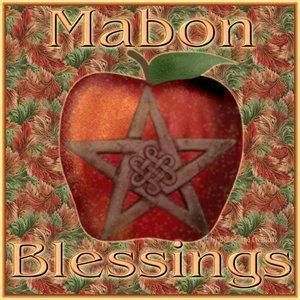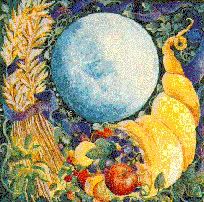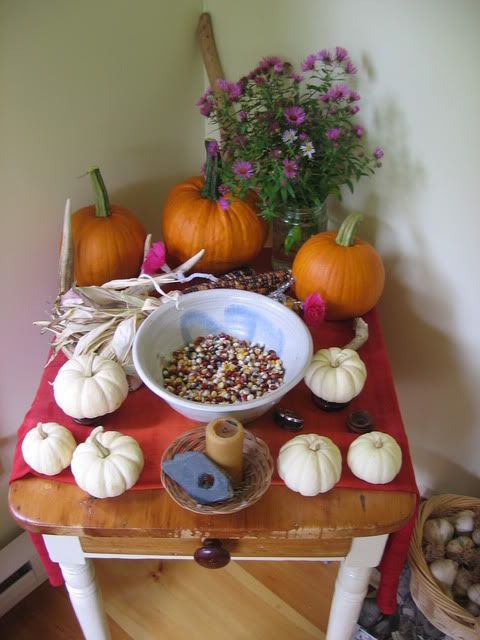Autumnal Equinox
"Autumn is the mellower season, and what we lose in flowers we more than gain in fruit." --Samuel Butler, English writer (1835-1902)
**************************************************
Ruth Calder Murphy Youtube channel
From the video description:
"Mabon Song" - By Ruth Calder Murphy: Click "Show More" for information and a copy of the lyrics. Enjoy!
"Mabon Song" is a song by Ruth Calder Murphy, with artwork also by Ruth Calder Murphy. The copyright belongs to Ruth Calder Murphy.
If you wish to use any of the material in my videos - lyrics, music or visuals - in a different context from the video itself, please feel free to contact me and always use full credits, please, including links to my web page(s) where possible.
If you've enjoyed and/or used my video, I'd love to hear from you!
I can be contacted through any of the following web pages:
www.arciemme.com
www.facebook.com/arciemmeparadoxologies
www.facebook.com/ruthsart
My Amazon page is here:
http://www.amazon.co.uk/Ruth-Calder-Murphy
 Lyrics for "Mabon Song"
Lyrics for "Mabon Song"Mabon Song
- by Ruth Calder Murphy -
Cut the corn and store the grain,
lay the Summer in the Earth,
die that life will come again;
Darkness leads to Light's rebirth.
Dance to Harvest gathered in,
Sing the song of golden corn,
Echoes of the far-off Spring,
Summer that will be re-born.
Cut the corn and store the grain,
lay the Summer in the Earth,
die that life will come again;
Darkness leads to Light's rebirth.
Dance to all that is Divine,
Sing with one exalting breath;
Join through every place and time -
Death in Life and Life in Death.
 Cut the corn and store the grain,
Cut the corn and store the grain,lay the Summer in the Earth,
die that life will come again,
Darkness leads to Light's rebirth.
Dance the dance of Evermore,
Sing the song of Everything,
Earth, air, fire and water, pour -
Harvest safely gathered in.
Cut the corn and store the grain,
lay the Summer in the Earth,
die that life will come again,
Darkness leads to Light's rebirth.
Dance to Spirit, infinite
Sing to Air, Fire, Water, Earth,
Dance the Day and dance the Night,
Darkness leads to Light's rebirth.
Cut the corn and store the grain,
lay the Summer in the Earth,
die that life will come again,
Darkness leads to Light's rebirth.
**************************************************
'The 2014 Autumnal Equinox Arrives'
By Emily Poore - SkyAndTelescope.com - September 22, 2014
What is the "fall equinox" — and how do we know when it happens?
To those who’ve unpacked their winter coats, closed their windows at night, and felt that telltale crispness in the air, it seems that autumn has already started. Astronomically speaking, however, the fall season only comes to the Northern Hemisphere on Tuesday, September 23rd at 2:29 Universal Time (10:29 p.m. EDT on Monday, the 22nd). At that moment, the Sun shines directly on Earth’s equator, heading south as seen in the sky. For us northerners, this event is called the autumnal equinox.
This seems awfully precise for seasons that gradually flow from one to the next, but the reason astronomers regard this event as the “End of Summer” and “Beginning of Fall” is because it is marked by a key moment in Earth’s annual orbit.
The apparent position of the Sun in our sky is farther north or farther south depending on the time of year due to the globe's axial tilt. Earth's rotational axis does not point straight up and down, like the handle of a perfectly spinning top, but is slanted about 23½° with respect to our orbit around the Sun.
 Another way to think of this is that the plane defined by Earth's orbit around the Sun (called the ecliptic) is tilted with respect to the planet's equator. From our perspective, the Sun follows the ecliptic in its path through the sky throughout the year. Each day the Sun's daily arc moves northward or southward, depending on the time of the year. To observers at northern latitudes (in the U.S., Canada, and Europe, for example), the Sun appears to sneak higher in the sky from late December to late June, only to drop down again from late June through late December. The equinox occurs when the Sun is halfway through each journey.
Another way to think of this is that the plane defined by Earth's orbit around the Sun (called the ecliptic) is tilted with respect to the planet's equator. From our perspective, the Sun follows the ecliptic in its path through the sky throughout the year. Each day the Sun's daily arc moves northward or southward, depending on the time of the year. To observers at northern latitudes (in the U.S., Canada, and Europe, for example), the Sun appears to sneak higher in the sky from late December to late June, only to drop down again from late June through late December. The equinox occurs when the Sun is halfway through each journey.This axial tilt also produces our seasons. When Earth is on one side of its orbit, the Northern Hemisphere is tipped toward the Sun and receives more direct solar rays (and more daylight hours) that produce the familiar climes of summer. Six months later, when Earth is on the opposite side of its orbit, the Northern Hemisphere is tipped away from the Sun. The slanting solar rays heat the ground less and daylight is shorter, producing the colder winter season.
The same pattern occurs, but in reverse, for the Southern Hemisphere. There September’s equinox marks the beginning of spring, while March’s equinox signals the start of fall. Christmas is a warm holiday in Sydney, Australia. For those living in equatorial regions, however, there are usually only two recognizable seasons: wet and dry; and the days themselves vary less in length.
Several other noteworthy situations happen on the equinoxes:
* Day and night are nearly the same length; the word “equinox” comes from the Latin aequinoctium, meaning “equal night,” according to the Oxford English Dictionary. However, a poke around your almanac will show that day and night are not precisely 12 hours each, for two reasons: first, sunrise and sunset are defined as when the Sun’s top edge — not its center— crosses the horizon. Second, Earth’s thick atmosphere refracts the Sun’s apparent position slightly when the solar disk sits very low on the horizon.
* The Sun rises due east and sets due west, as seen from everywhere on Earth; the equinoxes are the only times of the year when this occurs.
* Should you be standing on the equator, the Sun would pass exactly overhead at midday. Were you standing at the North Pole or South Pole, the Sun would skim completely around the horizon.
.


No comments:
Post a Comment